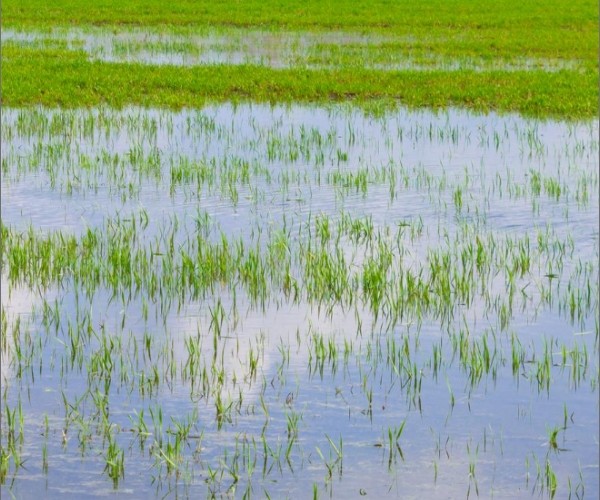- Lawn Turf
- Artificial
- Soil
- Timber
- Composite Decking
- Paving & Stone
Get In Touch With Our Experts Today!
Give us a Call! - Seed & Fertiliser
- Dressing
- Bark

June 21, 2023 Turf Tips
If the weather forecast looks like it might be a little soggy on the day you wanted to lay your new turf, the good news is, you can still go ahead as planned! First, though, take note of our advice as we answer all your questions on whether you can lay turf in the rain.
Although rain brings many benefits to our gardens (and saves the task of watering!), it can put a damper on things if you have outside jobs to complete.
Luckily, though, your new turf can still be laid in the rain – with some exceptions.
While a bit of dampness won’t do any harm, you don’t want to lay fresh grass on extremely muddy or sticky soil.
In this guide, we’ll discuss the impact of rain on your soil and turf while you’re laying it, and on fresh turf after you’ve laid it.
We’ll also provide some tips for successfully laying turf in wet weather, so you don’t have to reschedule your delivery or worry about the outcome.
| If you’ve not yet chosen your new turf for your outdoor space, choose George Davies for the best premium turf options.
As the landscaper’s choice and long-time suppliers of high-quality turf, there’s no better option for your garden or commercial project. |
Find the Best Turf for Your Garden Today

The short answer is yes, you can continue to lay your new turf in the wet weather while the soil is wet.
The bonus of choosing fresh turf is that you can roll it out in almost any weather conditions, provided your soil is thoroughly prepped and ready to go.
You should also make sure you know the correct technique for laying new turf, so you can achieve a professional look you’re happy with.
George Davies himself can help you there, with his in-depth YouTube video below.
We actually already have a blog post on how to lay turf in the rain, which will provide you with the right steps on how to achieve a successful installation.
Some of these include:
|
Save the guide below for when you’re ready to install your new turf…
Read Our Tips on Laying Turf in the Rain

A small amount of rainfall won’t harm your fresh new turf. In fact, it’ll provide your grass with a much-needed drink and help the roots anchor in.
However, there are a few signs to keep an eye out for, which could prevent your turf from getting the best head start.
So you can get the whole picture, here’s what you need to know before considering laying your turf in the rain.
| Positives of Laying Turf in Rain | Things to Watch Out For |
| ✔ Hydrated soil
Rain will naturally hydrate the soil, providing a perfect foundation for your turf to grow strong and healthy. |
✗ Soil consistency
Constant rain can create a sticky consistency in your soil. In this instance, try not to overwork the ground during the preparation stage, as it’ll become cake-like and make it difficult for the new turf to establish. |
| ✔ Grass blades are less likely to wilt
With a continuous supply of water, the grass blades are less likely to wilt and become stressed during the laying process, so they will have a better chance of rooting in and establishing themselves. |
✗ Soil compaction
If your lawn is still in use during rainfall and experiences high traffic from shoes, pets, or vehicles, the damp soil may become compacted. Not only could this result in uneven surfaces when you lay your turf, but it’s also harder for new roots to move through the soil or absorb essential water and nutrients. |
| ✔ There’s less stress on the new turf
Laying fresh turf can be stressful for the plants, as they are uprooted from their original location and replanted in a new environment. Rain helps reduce this stress by providing moisture and nutrients to the turf, allowing it to establish quicker with less risk of damage. |
✗ Lack of water
Although it’s raining, remember to check that the soil absorbs the water. If you notice water pooling on top or taking time to drain away, it could be a sign of poor soil, which can also lead to waterlogging and delay the installation of new turf. Our blog on how to fix a waterlogged lawn can help. |
| ✔ Helps the grassroots establish quicker
Rain helps the roots of new turf establish themselves in the soil by providing moisture and nutrients necessary for root growth. The grassroots can spread and grow faster, resulting in a healthier and more vibrant lawn. |
✗ Muddy turf
Naturally, with rain comes mud. And when you’re working outside, mud can cover your shoes and clothes, transferring onto your gorgeous green grass, perhaps not leaving you with that luscious-looking lawn you were hoping for. Simple solutions, such as using laying boards, can reduce the mess and protect your turf. |
As we said, turf can be laid in any weather, so don’t let a little rain put you off your project. It’ll be worth it!
Plus, drought is the most common killer of fresh turf, meaning rain can protect your investment.
But there are some things to watch out for before, so take note of those we’ve mentioned above.
As we said earlier, soil that’s become seriously saturated by rain can turn into a cake-like texture, which means it’s become waterlogged.
Waterlogged soil lacks proper drainage and contains minimal air pockets, making it unsuitable for laying turf.
If you attempt to lay turf in these conditions, the roots may struggle to establish themselves due to a lack of oxygen, and you might not get the results you were hoping for.
A small amount of rain on your freshly laid turf is fantastic for the plants, but a torrential downpour over several days is probably not ideal.
Read More: How to Care for Your Lawn After Heavy Rain
Excessive rainfall can saturate the soil beneath the turf, leading to poor root establishment and potential damage to the grass.
When your lawn becomes waterlogged, it can create an environment where the roots struggle to access necessary oxygen, increasing the risk of turf diseases or fungal growth.
To protect your new turf, consider monitoring the weather forecast and ensuring proper drainage to prevent standing water.
If heavy rain is expected, using a tarp or temporarily covering the turf can help minimise the impact. Once the rain subsides, allow the turf to dry slightly before walking on it or carrying out further care.
Living in good old drizzly Great Britain means rainy days aren’t hard to come by, and chances are, the moment you plan on doing some gardening work, you’ll be hit with a downpour.
So, don’t let the wet weather put you off revamping your garden or finishing your landscaping project. It’s not going anywhere, and it’ll probably have a positive impact.
The rainy season, like the April showers, can be a fantastic time to lay your turf so it sets in ready for the summer.
If you need any more advice or have any questions, head over to our blog or YouTube channel, where we have tons of expert advice on all things turf, or give us a ring, and we’ll be happy to help!
Speak to One of Our Turf Experts for Advice
Turf can be laid in the rain the same way it can be laid during dry weather – with adequate prep and the correct installation method.
Our blog post on how to lay turf in the rain can help, and we’ve also outlined a few tips in the blog post above!
Head to our blog or YouTube channel for advice on all things turf!
Yes! As long as your soil is workable, i.e., not waterlogged after a long torrential downpour, a bit of light rain shouldn’t put you off ordering and laying your new turf.
Even though you can lay your turf in the rain and survive wet weather, when it’s first laid, it can actually become too wet.
This can cause a waterlogged lawn, which comes with a host of other issues. Read the blog post above to learn more about this.
One common issue with laying turf in the rain is that it can cause the newly laid turf to turn yellow. This is often due to a lack of oxygen reaching the roots, as waterlogged soil can suffocate them.
If there’s too much water, it can wash away essential nutrients and leave the turf struggling to survive.
To avoid this, it’s important to make sure your soil has proper drainage and isn’t overly saturated before laying your turf.